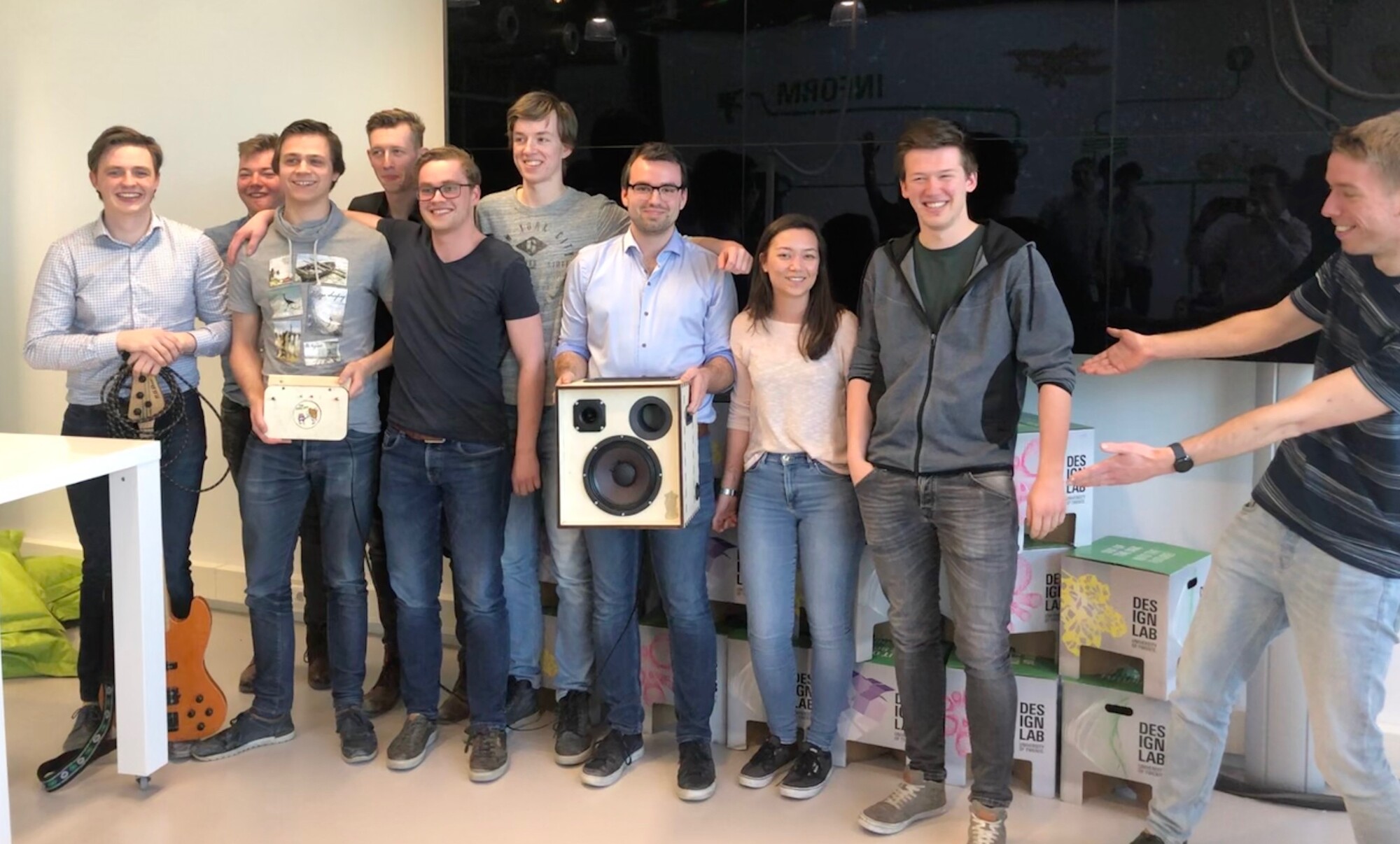D-I-Y Module 11
Almost at the end of the bachelor module 11 commences. During this module everything is based around one big project designing a Bluetooth/wireless speaker. What, how, and why is completely up to you. Two groups had the chance to write something about their experience with module 11.
Guus Frijters
My group and I (group 4D) had brainstorm sessions in order to figure out what the best speaker was to get the highest grade but which also would be fun to design. We had to think about it in order to achieve the ultimate philosopher bonus and the different subject needed to be integrated. This meant that there had to be analog processing as well as digital.
After multiple brainstorm sessions a few ideas came to light. The idea that won our contest was the UPASD. It is actually just a speaker which can recognize a beat and overlay a beat-sound, but we needed a cool name. Therefore the Ultra Portable Assistant Speaker for Dancing was born in the hope that the teacher would say the speakers name and we would be done with the module since we passed.
With the awesome idea present, division within the different domains could commence. The processing part is quite clear since we needed beat recognition. Therefore the digital domain could focus on beat recognition (and of course communication). This left the ‘speaker’-part open for some analog processing. Since we are all familiar with Module 3, the blown-up amplifiers, this was THE chance to use all knowledge gained over the years to design a better amplifier (which would not blow up). With the different parts integrated, a housing was needed to make our speaker look good as well. Using all the functions of the design lab as well as our inner creative minds, an acceptable looking speaker was born. All these different parts needed a glue to keep everything together which would be the Systems Engineers domain (as well as the project-leader). My task was to play the glue, which meant that I assisted where needed and wrote a lot of report and made a lot of diagrams.
Due to unforeseen sudden issues, the looks of the speaker changed (twice) to make sure everything would fit. Of course, most parts did not fit in the speaker anyways. Integrating the different parts also created big problems which made the project less successful as it was during our own testing. The demo did not go as well as we had hoped but luckily we could explain it away as issues with the components and not our own fault.
Guus’ group presenting their speaker.
Maarten Bonnema
Module 11 is, apart from the Bachelor assignment, probably the module with the most freedom. The task of the project is to design and prototype a portable speaker with a human touch. The kick-off of the project was right on the first day, so our group immediately started brainstorming. We came up with the wildest and craziest ideas. At the end we designed a portable speaker for semi-professional musicians, the Easy-Jam. The speaker would be an all-in-one portable unit that would combine all the functionalities of professional equipment into a single speaker.
In such a large project where multiple disciplines come into play; structure, organisation, and planning are key. Fortunately, the Systems Engineers and project leader in our group kept their heads cool and (tried) to manage the overview. Everyone in our team was divided into one or more subgroups to ensure all tasks would be fulfilled.
Using the knowledge of the courses Electronics and Embedded Signal Processing the analogue-group designed the front-end of the speaker chain, containing for example a line-select, pre-amplifier, and 3-band equalizer. Fortunately, this part of the chain was designed and constructed without major hassles.
Our main challenge was located in the digital domain. We opted to use an FPGA as some were quite prompt with VHDL in module 5. As a key functionality for the musicians, we implemented a looper station with pedal, where the user can loop his or her guitar and vocal clatter. We wanted to mix all the inputs digitally, for example, a microphone, a guitar, a backtrack from the Bluetooth receiver, and a signal from the looper. This brought about various challenges and problems, but we managed. Furthermore, the class D-amplifier proved to be one of the most demanding blocks. We asked our project supervisor for the code to convert from Pulse Code Modulation to Pulse Width Modulation, which ran at 750 kHz. The circuit that drove the loudspeakers turned out to be rather troublesome. We asked PhD-candidates various times for help and improved our design.
On the day of the final presentations, the same day as the deadline for the report, we were all stressed out to finalise the report and prepare a proper presentation. Like many other technical students we also procrastinated the writing of the report to the end, something that always backfires. Unfortunately, our speaker did not fully function during the demo, but we were still proud of what we achieved. Postponing the integration of multiple blocks to the last week, turned out to be the bottleneck. We learnt that planning and communication is crucial for the success of a large-scale and multidisciplinary project.
As a group of friends, we still had a lot of fun during the project. When module coordinator Oude Alink said that we could change our default group name, we came up with the group name ‘Winner Schnitzel’, a “winning name” according to Oude Alink. We had numerous ‘brainstorm’ sessions together and enjoyed fooling around from time to time. The most intriguing and appealing part of the project is that it does not only integrate the knowledge of the courses within the module, but it invites you to use all the know-how of the Bachelor and beyond.

Maarten’s group presenting their speaker.
